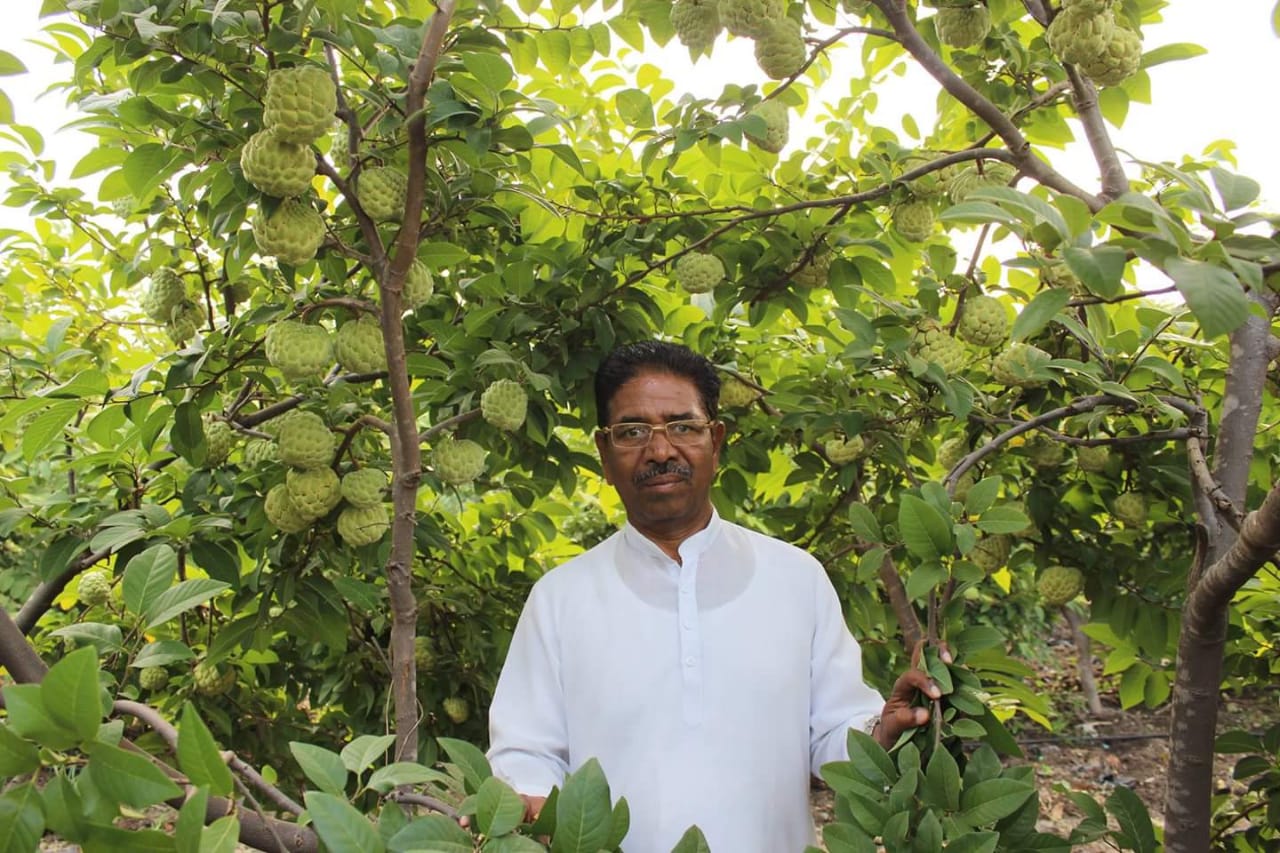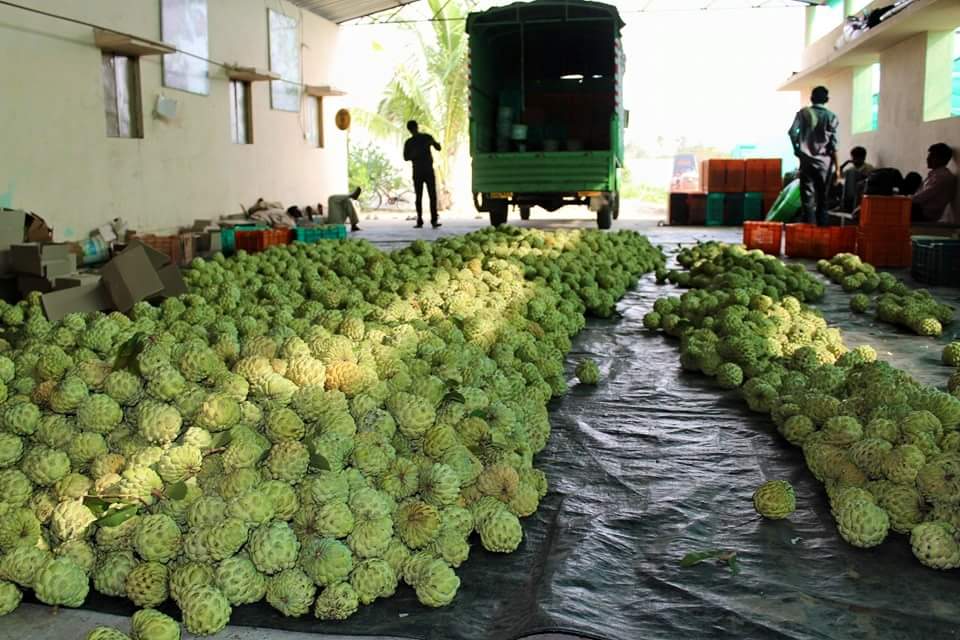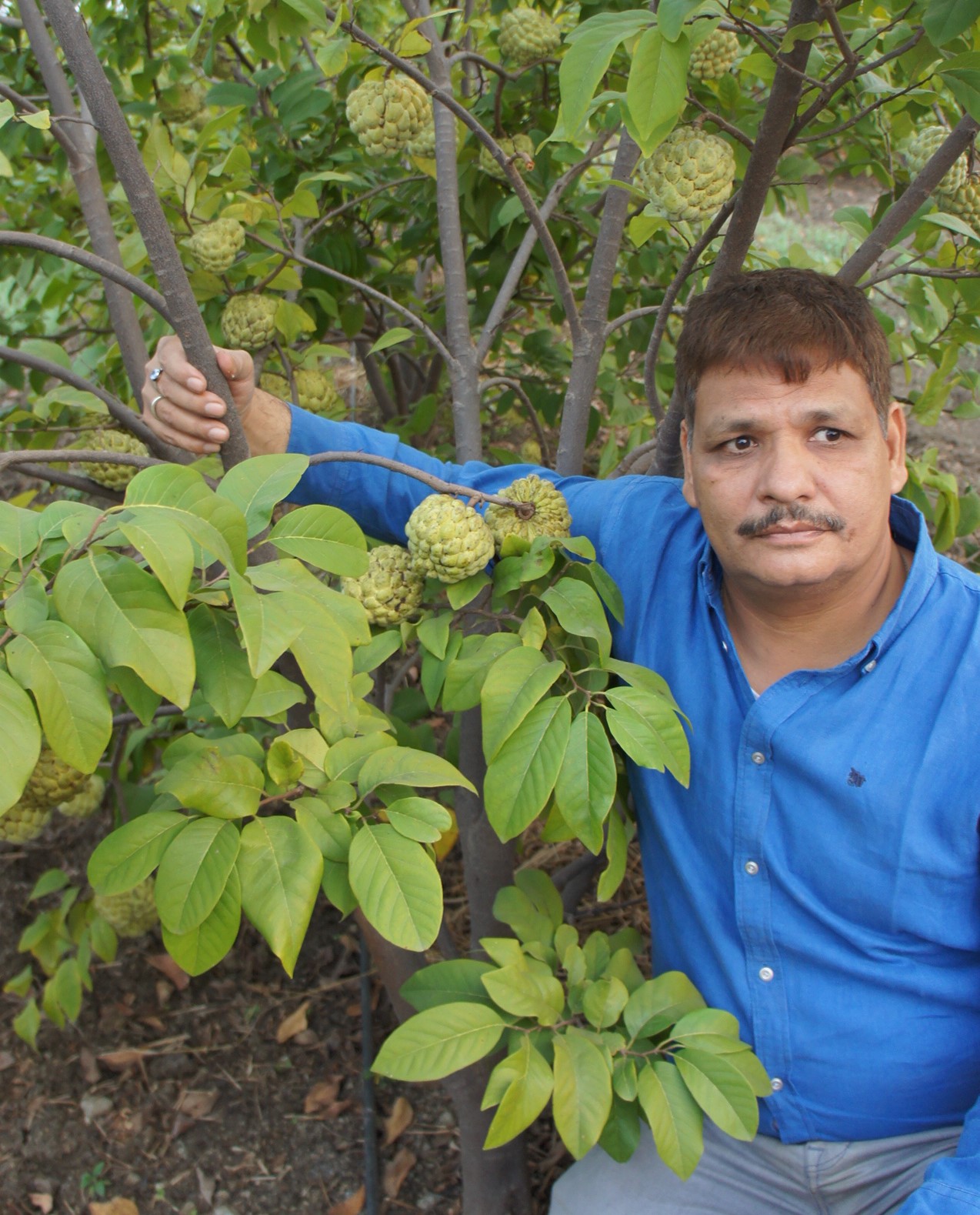Farmer Develops New Custard Apple That Doubles Yield, Has Fewer Seeds & More Pulp
Custard apple just got better, and the news couldn’t make us happier!

If you love sitaphal or custard apple, you’re likely to choose the fruit which promises a long shelf life, and has fewer seeds which don’t stick together. Once you cut open the fruit and find that it has thick, cream-white pulp, which is somewhat granular, you are finally happy with your choice. These are traits you can find in the NMK-01 variety.
Love custard apple? Check out this smoothie mix that you can have all-year round!
Those who wait for this fruit from the Annonaceae family to arrive early December have to thank farmer-innovator Navanath Malhari Kaspate of Gormale village in Solapur, Maharashtra. He has developed five other hybrid varieties of the fruit—Anona-2, NMK-01 (Golden), NMK-02, NMK-03 and Finger Prints—but considers NMK-01 (Golden) to be his illustrious one; it has fewer seeds, abundant pulp and rarely cracks when ripe.
Interestingly, its harvest can be extended after it matures and the yield doubles with every season.
As one arrives at his 50-acre Madhuban Farm and Nursery, like the scores of farmers wanting to grow the variety—all are greeted by a huge replica of the fruit at the arched entrance. The place is a ‘living museum’ of 42-odd varieties of custard apple collected from different parts of the world by 64-year-old Kaspate.
If you visit during the fruiting season, you’re likely to come across varieties with names like Anona Glabra, Pink’s Mammoth, Anona Muricata, Icecal, Washington Jem, Anona Montana and others.
Native to South America and the West Indies, sitaphal was introduced to India by the Portuguese during the 16th century AD. Amazingly, its appearance has been noted in ancient Indian sculptures. There is a depiction of custard apple in the Bharhut and Sanchi sculptures in Madhya Pradesh, the Ajanta Caves in Maharashtra, and the carvings at Mathura in Uttar Pradesh from the 2nd century BC.
Presently grown in 13 states of the country and Tanzania, mainly in dry-land zones, growers not only have a good word about the NMK-01 variety, but are all praises about the yield, which can be as high as 12 tonnes per acre.
The fruit has other varieties, namely Red Sitaphal, Balanagari, Washington and Purandhar, but it is the NMK-01 (Golden) whose acreage is increasing each year due to its acceptance from buyers and the remunerative results achieved by growers.
Being a dry land crop, the first two years are very crucial to its growth; it needs minimal irrigation and can be solely drip-fed. Because of this, there are fewer pest attacks.
Kaspate’s farm is unique as it happens to be the country’s largest nursery devoted to sitaphal, serving as a development and research centre too. Developing a new variety is generally undertaken either by universities or institutions like the Indian Institute of Horticultural Research. But in this case, it was a class 11 dropout, who had the passion of a grower and the perseverance of a plant breeder.
“I used to grow grapes and ber (Indian jujube) like many others here, but having developed the variety in 2001 and giving it my name, I converted my entire farm to sitaphal,” says Kaspate, the man who introduced the farming community to NMK-01 (Golden) in 2011.
Five years later, he was awarded the Plant Genome Saviour Farmer Reward constituted by the Protection of Plant Varieties and Farmers’ Rights Authority. He received a cash prize of Rs 1 lakh for the same. Ahmednagar-based Mahatma Phule Krishi Vidyapeeth is a recipient of the germplasm of 16 sitaphal varieties gifted by Kaspate.
Ever since NMK-01 (Golden) was launched, the innovator claims to have sold 30 lakh saplings to the hundreds of farmers who visited his farm for his workshops, or to those who seek him out after watching his videos on YouTube. He makes at least Rs 1 crore from selling the fruit which he brands as being from “Madhuban Farm and Nursery”. The saplings that are sold here at Rs 60 each also add to his earnings.
Among the earliest farmers who took to growing NMK-01 (Golden) is one Nandlal Dhakad (45) of Jaisinghpura village in Chittorgarh district of Rajasthan. He watched Kaspate’s videos and visited his farm in Barshi, and planted 400 saplings on his teen bigha zameen (which is less than an acre) in 2011. Four years later, he received a harvest of 10 quintals, earning Rs 2-3 lakh per year.
“I have been getting a very good harvest, but this year, due to excessive rainfall, my harvest has been greatly affected,” he says.
Besides two post-graduate degrees, he also holds a diploma in computer applications. Nandlal is an award-winning farmer who grows exotic vegetables and betel leaves, using the principles of jaivik kheti (organic farming).

Most fruit lovers shun the sitaphal due to its excessive seeds. And that’s where NMK-01 (Golden) scores. According to a comparative study undertaken by a researcher at Mohali-based National Agri-Food Biotechnology Institute, NMK-01 (Golden) was found to be superior to the Balanagari in taste and nutrition. While the Balanagri had 70+ seeds, the NMK-01 (Golden) barely touched 15!
Giriraj Gupta of Narsingarh village in Madhya Pradesh, says, “You may not believe it, but I got a fruit which weighed around 730 grams, and I had to share it with three others. Interestingly, it had just ten seeds.”
He continues, “Each tree yields at least 20 kg of fruit from the third year of plantation. An acre holding 340 trees yields an average of seven to eight tonnes a season. In 2015, I had planted it on eight acres. This year, I hope to make around Rs 12 lakh from its harvest.”
It was the promise of plentiful pulp that prompted Ramesh Pawar (46) to plant Kaspate’s variety on his 80-acre drip-irrigated farm in Chikodi village, Belgaum, Karnataka in 2012. Having read about the NMK-01 variety in a Kannada weekly, he visited Madhuban and acquired nearly 28,000 saplings which were a year-old. “I harvest about four tonnes per acre and this is likely to increase with successive years. I am looking forward to making at least Rs 1 crore by the next season,” he shares.
Also Read: These Maharashtra Farmers Are Earning Lakhs By Growing a Desi Superfood!
The variety which arrives in the market in early December has brought in cheer among farmers in the country’s dry land areas. And as the word spreads, more and more farmers are switching to NMK-01.
(Edited by Shruti Singhal)
Like this story? Or have something to share?
Write to us: [email protected]
Connect with us on Facebook and Twitter.
This story made me
- 97
- 121
- 89
- 167
Tell Us More
We bring stories straight from the heart of India, to inspire millions and create a wave of impact. Our positive movement is growing bigger everyday, and we would love for you to join it.
Please contribute whatever you can, every little penny helps our team in bringing you more stories that support dreams and spread hope.



















